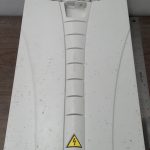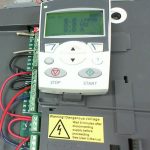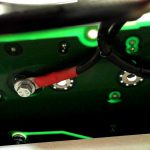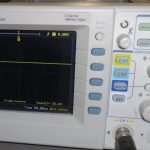“Operator heard a BANG when they turned the system on; drive does not function when power is applied.” That’s from our customer and a very unhappy scene played out in small shops and manufacturing plants around the country. A dramatic “call for help” from this ABB variable frequency drive! The result: Drive repairs needed!
So, what happened to this ABB VFD drive?
 In this case, it’s a perfect example of aging components combined with accumulated dirt. Inspection showed arc damage on the base in the area of the 3 phase A/C bridge module as well as some discrepancy in the gate circuits.
In this case, it’s a perfect example of aging components combined with accumulated dirt. Inspection showed arc damage on the base in the area of the 3 phase A/C bridge module as well as some discrepancy in the gate circuits.
This ABB VFD ACS550-U1-059A-2+B055, Model: ACS550 first got a much needed thorough cleaning right down to the circuit boards and all components were tested. Repairs included replacing the 3 phase A/C bridge rectifier module and IGBT output module. A little detective work, a lot of cleaning and some new components put this ABB variable frequency drive back to work for our New England customer. ABB drive repairs successful! Pretty good news considering the dramatic call for help!

Drives, like any other electronic, have a lifetime – and their internal components do too! Aging components is the single most common reason for failure. Capacitors are often the first component to fail. Other likely failure culprits include resistors, diodes, IGBTs, driver ICs, relays, transistors, transformers, opto-isolators, and rectifiers, as well as others. Drive repairs are often successful and worth the investment.
But, what else could go wrong with my drive?
Plenty as it turns out. An example would be “ripple”. We are going to try to keep it short and simple, but this might get a little complicated, so hang on. Ripple voltage, or surge current, in electronics is residual periodic variation of the DC voltage within a power supply which comes from an alternating current (AC) source. This ripple is the result of incomplete suppression of the alternating waveform after rectification. Ripple voltage originates as the output of a rectifier or from generation and commutation of DC power.
Essentially, ripple current, is wasted power, and causes unwanted effects in a DC circuit: overheated components, noise and distortion, and can sometimes cause digital circuits to malfunction. None of that is good for your drives.
Useful information about drives and ripple to know:
Normal DC ripple is typically between 5V and 10V for a functioning drive. If the ripple voltage is greater than 30 to 40V, then you likely have a problem. Some of the possible problems include:
- One of the input diodes of the drive failed
- One AC input phase lost
- Unbalance on the AC input voltage
- Impedance unbalance on the AC input line
- DC bus capacitor is failing
- Drive is undersized for the application
What can you do about ripple?
A ripple or surge problem can be reduced by an electronic filter, and eliminated by a voltage regulator
Here’s another recent ripple-related case study:
This ABB drive needed modifications for repurposing. Ripple was a factor in the modification process.


Do you have questions or concerns about your servo drive, or do you think you may need drive repairs? If it’s still under warranty, contact your OEM. If it is out of warranty, contact an independent industrial electronic repair center. They should offer free evaluations for your servo drive and, if needed, a free quote for repairs. They should also provide repair reports and a good warranty that covers both parts and labor. Here’s a link if you want to find out more about signs your servo drive might need repairs?
About the Author: ACS Industrial is an independent industrial electronic repair center providing repair services for servo drives and motors of all types and most all manufacturers as well as for AC/DC drives, VFD drives, encoders, printed circuit board repairs, monitors and touchscreens, PLCs, test equipment, and much more. Our knowledgeable and helpful customer service team is available to answer your questions and help solve your toughest industrial electronic repair concerns. Legacy equipment can be repaired! RUSH Service is available. You can reach ACS Industrial Services by calling 800-605-6419
